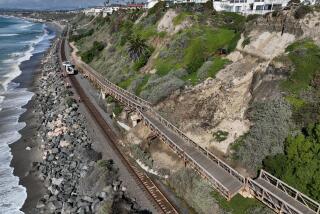Op-Ed: How to boost L.A.’s sinking transit ridership
There’s collective angst among proponents of local transit about the news that ridership in Los Angeles has been falling. As this paper reported recently, the region has lost more than 10% of its riders since 2006 — a discouraging result given the billions in federal, state and local dollars invested in the system.
While the decline is a problem, we should be careful not to overstate it, nor to attribute it solely to local decision-making. First, it is part of a nationwide trend, due to myriad factors such as temporarily cheap oil, greater use of ride-hailing services, and more bike commuters, among other factors. In other words, much of the drop off is due to trends outside of the region’s control.
Join the conversation on Facebook >>
Second, some of the local data are misleading. For example, news reports have noted that ridership is down not only in the last few years, but since 1985, when Metro recorded 497 million boardings versus 453 million in 2015. Basing the comparison on 1985 doesn’t paint a complete picture, however, as that was the absolute high-water ridership year from the past four decades. That fiscal year saw an unusual spike due primarily to a temporary reduction in bus fares. So cherry-picking 30-year data makes the trend look more severe than it really is. You could just as easily note the ridership increase over the last 15 or 25 years.
We also shouldn’t assume that the decline means the billions of dollars that county voters approved in 2008 for rail transit expansion have been ineffective. The new lines funded by that sales tax increase will fill critical gaps in the rail network, but they haven’t come on line yet. Crucial rail extensions, such as the subway under Wilshire Boulevard and light rail through downtown and out to Santa Monica, will open starting this year and over the next few. Only after those openings can we determine the true return on taxpayer investments.
At the same time, we should recognize that there’s a legitimate cause for concern and a corresponding need for action. Building out the long-overdue rail network will only address part of the problem. Much of the ridership decrease relates to the bus system, which carries the bulk of transit riders across the region. Cutbacks to service and higher fares during years of economic recession have taken their toll. If transit leaders want to improve ridership, they need to find ways to reduce fares and make them more equitable, such as by accounting for distance traveled and providing universal passes for students.
Local leaders can also improve service by allowing more bus-only lanes on major arterials and on freeways. These relatively low-cost options would make use of existing infrastructure and provide a huge time-savings to transit riders.
Given the stakes, it makes sense to prioritize passage for buses carrying more people than single-occupancy vehicles. And more people would take transit if they knew it would save them time compared to being stuck in traffic.
If transit leaders want to improve ridership, they need to find ways to reduce fares and make them more equitable.”
Finally, we could boost ridership on rail and major bus lines by building more homes and offices within convenient walking distance of the stations. Lower-income residents are more likely to ride transit, so allowing affordable housing near transportation hubs is a proven ridership generator. In addition, people are more likely to take transit if their jobs are close to a stop.
For now, it’s unclear whether Los Angeles residents and leaders have the vision and political will to create denser neighborhoods around rail stations. On the positive side, some parts of Los Angeles County have become thriving hubs of walkability, from Downtown Los Angeles to Hollywood to Long Beach. Other areas have resisted the change. While they’re happy to receive subsidized rail at taxpayer expense, they refuse to accommodate growth that would make the system more cost-effective, provide badly needed housing to address the region-wide shortage, and bring tax revenue to their communities.
Los Angeles now leads the country with its investments in transit, particularly rail. While the job of building a comprehensive network is not yet done, the new lines under construction will fill in the gaps and finally make the system comprehensive and convenient to millions of residents. With further improvement to the bus system and smart development around rail, Los Angeles can show the country how to lead on boosting ridership as well.
Ethan N. Elkind researches and writes on environmental law and policy with a joint appointment at the UC Berkeley and UCLA Schools of Law. He is the author of “Railtown: The Fight for the Los Angeles Metro Rail and the Future of the City.”
Follow the Opinion section on Twitter @latimesopinion andFacebook
MORE FROM LIVABLE CITY:
What L.A. can learn from a Portland homeless encampment
Does killing urban coyotes create more problems than it solves?
That feels better, L.A. – fixes for four of the city’s sorest joints
More to Read
A cure for the common opinion
Get thought-provoking perspectives with our weekly newsletter.
You may occasionally receive promotional content from the Los Angeles Times.






